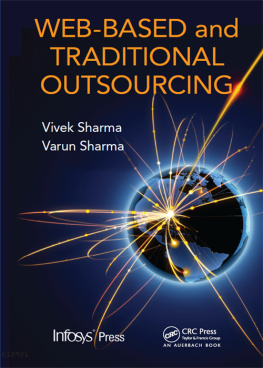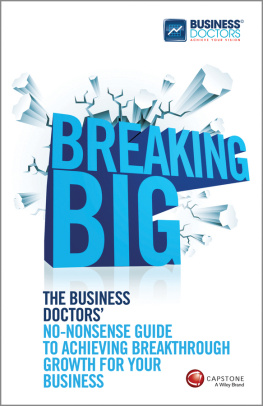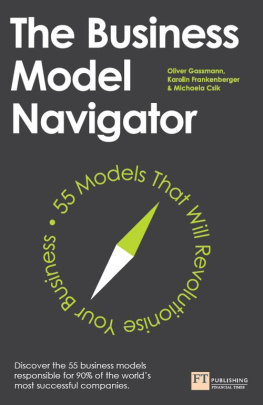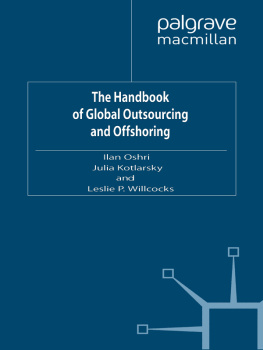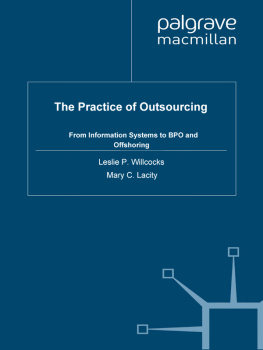
In an initiative to promote authorship across the globe, Infosys Press and CRC Press have entered into a collaboration to develop titles on leading edge topics in IT.
Infosys Press seeks to develop and publish a series of pragmatic books on software engineering and information technologies, both current and emerging. Leveraging Infosys extensive global experience helping clients to implement those technologies successfully, each book contains critical lessons learned and shows how to apply them in a real-world, enterprise setting. This open-ended and broad-ranging series aims to brings readers practical insight, specific guidance, and unique, informative examples not readily available elsewhere.
PUBLISHED IN THE SERIES
.NET 4 for Enterprise Architects and Developers
Sudhanshu Hate and Suchi Paharia
Process-Centric Architecture for Enterprise Software Systems
Parameswaran Seshan
Process-Driven SOA: Patterns for Aligning Business and IT
Carsten Hentrich and Uwe Zdun
Web-Based and Traditional Outsourcing
Vivek Sharma and Varun Sharma
IN PREPARATION FOR THE SERIES
Scrum Software Development
Jagdish Bhandarkar and J. Srinivas
Software Vulnerabilities Exposed
Sanjay Rawat, Ashutosh Saxena, and Ponnapalli K. B. Hari Gopal
WEB-BASED and
TRADITIONAL
OUTSOURCING
Vivek Sharma
Varun Sharma

CRC Press
Taylor & Francis Group
6000 Broken Sound Parkway NW, Suite 300
Boca Raton, FL 33487-2742
2011 by Taylor & Francis Group, LLC
CRC Press is an imprint of Taylor & Francis Group, an Informa business
No claim to original U.S. Government works
Version Date: 20120113
International Standard Book Number-13: 978-1-4665-5143-5 (eBook - ePub)
This book contains information obtained from authentic and highly regarded sources. Reasonable efforts have been made to publish reliable data and information, but the author and publisher cannot assume responsibility for the validity of all materials or the consequences of their use. The authors and publishers have attempted to trace the copyright holders of all material reproduced in this publication and apologize to copyright holders if permission to publish in this form has not been obtained. If any copyright material has not been acknowledged please write and let us know so we may rectify in any future reprint.
Except as permitted under U.S. Copyright Law, no part of this book may be reprinted, reproduced, transmitted, or utilized in any form by any electronic, mechanical, or other means, now known or hereafter invented, including photocopying, microfilming, and recording, or in any information storage or retrieval system, without written permission from the publishers.
For permission to photocopy or use material electronically from this work, please access www.copyright.com (http://www.copyright.com/) or contact the Copyright Clearance Center, Inc. (CCC), 222 Rosewood Drive, Danvers, MA 01923, 978-750-8400. CCC is a not-for-profit organization that provides licenses and registration for a variety of users. For organizations that have been granted a photocopy license by the CCC, a separate system of payment has been arranged.
Trademark Notice: Product or corporate names may be trademarks or registered trademarks, and are used only for identification and explanation without intent to infringe.
Visit the Taylor & Francis Web site at
http://www.taylorandfrancis.com
and the CRC Press Web site at
http://www.crcpress.com
The essence of lifein two words knowledge and action.

Foreword
With hardly any foreign exchange reserves in 1990, Indias government was forced to change economic policies, and thus the economic liberalization opened up gates for new industries. Over the last 15 years, on the strength of rupee depreciation and cost arbitrage, India has grown into an economic powerhouse with one of the highest GDP growths for emerging economies. Coupled with an abundant English-speaking talent pool essential for the information technology (IT) and information technology enabled services (ITES) industry, India is one of the destinations for most IT companies to set up operations. India was earlier viewed as a cost arbitrage opportunity, but today it is a strategic IT destination. Some of the institutions like the Indian Institute of Technology (IIT), the Indian Institute of Management (IIM), and the Indian School of Business (ISB) are ranked among the top engineering and management institutions in the world. Each year, world-class companies come to these campuses to pick up talent for their global operations. Every large product company like Microsoft, Oracle, Intel, SAP, etc., has a large R&D hub out of India which works on cutting edge technologies by leveraging the talent pool available in the country.
The Indian IT industry has grown by leaps and bounds with the economic liberalization. In the 1990s most of the U.S. companies were looking at reducing their IT labor cost (including work for Y2K), and Indian IT vendors were mainly working on maintenance and smaller enhancements of existing projects. Hence, the Indian IT industry was mostly viewed as a cost arbitrage for U.S. companies in those days. Using Y2K as an entry point, many Indian IT vendors made entries into IT services, and over a period of time Western businesses developed greater confidence regarding IT outsourcing to the Indian providers. Some Indian IT vendors redefined the outsourcing landscape as they successfully competed with the IBMs and Accentures of the world. Indian service providers used the different time zones (especially between the United States and India) for strategic advantage by offering business continuity over these zones. The trend moved toward outsourcing of larger projects to Indian vendors, and the India IT industry steadily expanded on its competencies and now includes both niche players offering specific services and generic companies offering end-to-end services. With hardly any Indian vendor having revenues of $10 million in the early 1990s, today at least a few of the them have more than a billion dollars of profit. Accentures and IBMs also have large setups in India. In the consolidation phase of the IT industry today, Indian vendors are taking the lead and expanding their reach by acquiring niche consulting players to increase their competencies.
Western companies are increasingly looking at Indian IT vendors as strategic partners in order to focus on core competencies and gain competitive advantage. Vendors are expected to not only define the technology landscape but also take complete end-to-end responsibility for IT infrastructure and bring a strategic business advantage. Indian industry has a robust outsourcing business with the United States, and in the last few years they have also expanded their footprint in Europe and other parts of the world. Being aware of the best practices, Indian vendors are now able to set up global centers of excellence in related business verticals and efficiently make use of cross-domain knowledge.
Next page
